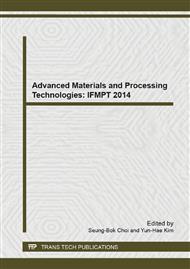[1]
The editorial board of Xinjiang Flora(EBXF). (1973) Xinjiang Flora (Book II, fascicle II) [M]. Urumchi: Xinjiang People's Publishing House, 6.
Google Scholar
[2]
The editorial board of CAS Flora(EBCF). (1974) The Flora of China[M]. Beijing: science and technology publishing house, 2848.
Google Scholar
[3]
Xinjiang municipality Ministry of Health(XMMH). (1975) Xinjiang Chinese herbal medicine[M]. Urumchi. Xinjiang people's publishing house, 92.
Google Scholar
[4]
Yao L, Zhao H, Shen L. (2005) The study of tissue culture rapid propagation of Sorbus sibirica fruits. Liaoning Agricultural Science, (6): 19-21.
Google Scholar
[5]
Li D and Chen J. (1995) The pharmacological research of the water extraction of Sorbus tianchanica. Chinese herbal medicine, 26(6): 302.
Google Scholar
[6]
Li D and Chen J. (1998) The pharmacological research of the ethanol extraction of Sorbus tianchanica. Northwest Pharmaceutical journal, 13(2): 10.
Google Scholar
[7]
Chen J, Wang Y, Aimaiti J. (2001) The research of Tien rowan original plant, chemical components and pharmacological activity. China's basic doctor of traditional journal, 7: 45.
Google Scholar
[8]
Song Xiaokai. (2004) Natural drug chemistry[M]. Beijing: Chemical Industry publishing house, 74-77.
Google Scholar
[9]
Birt DF, Hendrich S, Wang W. (2001) Dietary agents in cancer, prevention: flavonoids and isoflavonoids. Pharmacol Ther, 90: 157-177.
DOI: 10.1016/s0163-7258(01)00137-1
Google Scholar
[10]
Bors W and Michel C. (2002) Chemistry of the antioxidant effect of polyphenols. Ann N Y Acad Sci, 957: 57-69.
Google Scholar
[11]
Manach C, Scalbert A, Morand C, Rémésy C, Jiménez L. (2004) Polyphenols: food sources and bioavailability. Am J Clin Nutr, 79: 727-747.
DOI: 10.1093/ajcn/79.5.727
Google Scholar
[12]
Halliwell B, Rafter J, Jenner A. (2005) Health promotion by flavonoids, tocopherols, tocotrienols, and other phenols: direct or indirect effects? Antioxidant or not?. Am J Clin Nutr , 81(1 Suppl): 268S-276S.
DOI: 10.1093/ajcn/81.1.268s
Google Scholar
[13]
Williamson G, Manach C. (2005) Bioavailability and bioefficacy of polyphenols in humans. II. Review of 93 intervention studies. Am J Clin Nutr , 81(1Suppl): 243S-255S.
DOI: 10.1093/ajcn/81.1.243s
Google Scholar
[14]
Arts IC. (2008) A review of the epidemiological evidence on tea, flavonoids, and lung cancer. J Nutr, 138: 1561S-1566S.
DOI: 10.1093/jn/138.8.1561s
Google Scholar
[15]
Tomar RS, Shiao R. (2008) Early life and adult exposure to isoflavones and breast cancer risk. J Environ Sci Health C Environ Carcinog Ecotoxicol Rev, 26: 113-173.
DOI: 10.1080/10590500802074256
Google Scholar
[16]
Linseisen J and Rohrmann S. (2008) Biomarkers of dietary intake of flavonoids and phenolic acids for studying diet-cancer relationship in humans. Eur J Nutr 47: 60-68.
DOI: 10.1007/s00394-008-2007-x
Google Scholar
[17]
De Kok TM, van Breda SG, Manson MM. (2008) Mechanisms of combined action of different chemopreventive dietary compounds a review. Eur J Nutr 47(Suppl2): 51-59.
DOI: 10.1007/s00394-008-2006-y
Google Scholar
[18]
Zheng W and Wang SY. (2001) Antioxidant activity and phenolic compounds in selected herbs. J Agric Food Chem 49, 5165-5170.
DOI: 10.1021/jf010697n
Google Scholar
[19]
Choi DB, Park SS, Ding JL, and Cha WS. (2007) Effects of Fomitopsis pinicola extracts on antioxidant and antitumor activities. Biotechonol Bioprocess Eng 12, 516-524.
DOI: 10.1007/bf02931349
Google Scholar
[20]
Kang KS, Kim ID, Kwon RH, and Ha BJ. (2008) Undaria pinnatifida fucoidan extract protects against CCl4-induced oxidative stress. Biotechnol Bioprocess Eng 13, 168-173.
DOI: 10.1007/s12257-007-0101-1
Google Scholar
[21]
Li C and Wang M. (2011) Antioxidant Activity of Peach Blossom Extracts. J. Korean Soc. Appl. Biol. Chem. 54(1), 46-53.
DOI: 10.3839/jksabc.2011.006
Google Scholar
[22]
Liu Y, Yang Y, Jia W. (2006) The research of the Determination method of total flavonids from medicinal mulberry huang. Acta Edulis Fungi, 13(2): 45-48.
Google Scholar
[23]
Zhao Y, Patiguli·MA. (2005) The Determination and Extraction of Total Flavonids from Sorbus tianschanica of Variety Organs in Xinjiang. Food Science, 26(9): 414-415.
Google Scholar
[24]
Rui M, Tang H. (2009) Study on the Extracting Tota l Flavano ids from Sorbus Tianshan. Lishizhen Medicine and Materia Medica Research, 20(12): 3038-3040.
Google Scholar
[25]
Chen Y and Feng Y. (2012) Optimization of Microwave-assisted Extraction Process for Polysaccharides from Ginggo biloba Leaves and Anti-oxidant Activity in Vitro. Food Science, 33(6): 24-28.
Google Scholar
[26]
Zhang H and Chen J. (2008)Study on Extraction Technology by Ultrasound and Antioxidation in vitro of Honeybee Pupa Flavonoids. Food Science, 29(2): 158-162.
Google Scholar
[27]
Mo K, Liu S, Cheng C. (2006) Study on Antioxidant Activity of the Ginger Flavonoid. Food Science, 27(9): 110-115.
Google Scholar
[28]
Amarowicz R, Zegarska Z, Rafalowski R. (2009) Antioxidant activity and free radical-scavenging capacity of ethanolic extracts of thyme, oregano, and marjoram. Eur J Lipid Sci Technol, 111: 1111-1117.
DOI: 10.1002/ejlt.200800170
Google Scholar
[29]
Wang F, Ruan Y, Liu C. (2011) Antioxidant Activity in vitro of Total Flavonoids from Actinidia arguta. Food Science, 32(17): 168-171.
Google Scholar
[30]
Zhang S, Gong Z, Shi X. (2011)Antioxidant Effect of Total Flavonoids from Zanthoxylum bungeanum Seeds. Food Science, 32(15): 70-73.
Google Scholar
[31]
Hu W, Shen T, and Wang MH. (2009) Free radical scavenging activity and protective ability of methanolic extract from Duchesnea indica against protein oxidation and DNA damage. J Food Sci Nutr , 14: 277-282.
DOI: 10.3746/jfn.2009.14.4.277
Google Scholar
[32]
Ock-Sook Yi. (1997) Antioxidant activity of grape extracts in a lecithin liposome system. JAOCS, 74: 1301-1306.
Google Scholar
[33]
Yen GC and Chen HY. (1995) Antioxidant activity of various tea extracts in reation to their antimutagenicity. J Agric Food Chem, 43: 27-32.
DOI: 10.1021/jf00049a007
Google Scholar
[34]
Li Y and Meng X. (2008) Studies on Antioxidant Activity of flavonoids from Leaves of Blueberry. Acta Nutrimenta Sinica, 30 (4): 427-429.
Google Scholar


